
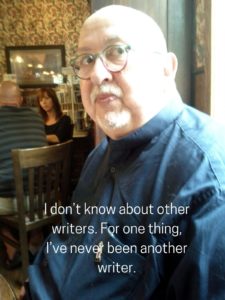 I don’t know about other writers. For one thing, I’ve never been another writer. For another, although I’ve observed practically all the interviews, or as in this case requested from writers, are about how the writing is done, creative tricks, recipes and such. I can’t listen to, view, or read that stuff…not that it isn’t full of useful information, just that my attention wanders, or I fall asleep. So, the nice guy who works for the publisher and arranges this kind of thing told me it would be a good idea if I wrote something about writing. And I just told you that I really don’t know anything about how other writers do it.
I don’t know about other writers. For one thing, I’ve never been another writer. For another, although I’ve observed practically all the interviews, or as in this case requested from writers, are about how the writing is done, creative tricks, recipes and such. I can’t listen to, view, or read that stuff…not that it isn’t full of useful information, just that my attention wanders, or I fall asleep. So, the nice guy who works for the publisher and arranges this kind of thing told me it would be a good idea if I wrote something about writing. And I just told you that I really don’t know anything about how other writers do it.
...
It’s so easy to feel overwhelmed by”¦ everything right now.
Climate change, the rise of authoritarianism, the economy, systemic racism, a global pandemic. Social media (which arguably has never been a showcase for the best humanity has on offer) has become a doom scroll. The news headlines aren’t comforting either, obviously, as that’s not their job, but feel even less so this year.
Meanwhile, Life with a capital L keeps happening. We all still have to keep a roof over our heads, some of us have kids to feed and prepare for whatever the hell it is that lies ahead, or parents to support in their old age, or maybe even both. An appalling number of us have to fight daily just for the right to exist.
And worst of all, I think, is that it is the year 2020. There’s something extra galling about the fact that we’re nearly a quarter way through the 21st century and we literally have access to the sum total of the world’s knowledge in our pockets”¦ and yet we seem to be inundated with both egregious ignorance and aggressive gullibility. Never mind a jet pack, I’d be happy just to get everyone on the same damn page: Clean air good, pollution bad.
 On my darker days, I tend to turn to accounts from other people who lived through uncertain or frightening times. Victor Frankl’s Man’s Search for Meaning comes to mind, or going further back, something like Pandaemonium by Humphrey Jennings. An obvious place to look for historical parallels right now is back to our most famous pandemic, even if our perception of those times isn’t entirely accurate. These books and essays don’t offer answers, per se, but they do provide that all important connection: other people have been in a crucible and survived, and maybe you can too.
On my darker days, I tend to turn to accounts from other people who lived through uncertain or frightening times. Victor Frankl’s Man’s Search for Meaning comes to mind, or going further back, something like Pandaemonium by Humphrey Jennings. An obvious place to look for historical parallels right now is back to our most famous pandemic, even if our perception of those times isn’t entirely accurate. These books and essays don’t offer answers, per se, but they do provide that all important connection: other people have been in a crucible and survived, and maybe you can too.
But what can you do beyond just get by? These problems we’re facing seem so big and intractable. You’re just one person, right?
Listen: One person can make a difference.
Here’s how I know. On May 16th, 2020, more than 5000 volunteers in my community, following physical distancing protocols and wearing masks, collected at least 678,200 pounds””yes pounds, and no that amount is not a typo””of food, donated by residents who had been asked to leave a non-perishable item on their porch or front step for collection.
The goal was to restock local food banks, because donations had tailed off due to the pandemic lockdown. Organizers called it the May 16th Miracle, and the whole effort was put together in less than three weeks via social media and the now ubiquitous Zoom.
The Miracle”¦ was just one person’s idea.
It was not a government initiative, it wasn’t put together by a big non-profit organization, and it had no budget for publicity. One person saw that others were hurting, reached out to a few other people who would be able to recognize the same need, and this small group of people then put out the call to the community at large. And wow, did the community respond.
Even better, a neighbouring community was so inspired by the effort that they organized their own miracle and brought in even more donations for their food banks.
I took part in the May 16th Miracle as an area “˜captain,’ and the experience of collecting bag after bag of goods from my neighbours, and then joining the huge convoy en route to a makeshift warehouse has sustained me ever since. I’ve started noticing quiet success stories all over the place: the Facebook gardening group members giddily sharing pictures of the monarch caterpillars they’re now seeing in the gardens they’ve overhauled to include native species; the grassroots pressure that forced universities and other institutions to divest from oil and gas holdings; the proliferation of Pride rainbow crosswalks in even those most conservative of towns; colonial-era statues finally, finally coming down.
Yes, it’s 2020. No, we shouldn’t have to still be fighting these fights. But what you’re doing, however big or small your contribution, is working. Indeed, there wouldn’t be so much pushback if it weren’t.
Keep going. Double down if you can. It matters.
You matter.
 BIO: Chandra Clarke (she/her) is the author of the Pundragon (available August 10), a cli-fi book disguised as a humorous fantasy. You can find her blog at www.chandrakclarke.com or say hi on Twitter at @chandraclarke.
BIO: Chandra Clarke (she/her) is the author of the Pundragon (available August 10), a cli-fi book disguised as a humorous fantasy. You can find her blog at www.chandrakclarke.com or say hi on Twitter at @chandraclarke.
If you’re an author or other fantasy and science fiction creative, and want to do a guest blog post, please check out the guest blog post guidelines. Or if you’re looking for community from other F&SF writers, sign up for the Rambo Academy for Wayward Writers Critclub!
...
Audiobooks are the current gold rush in publishing””or so they say, and you know “they” always know what they’re talking about. If you don’t get on the audiobook wagon, you are sure to lose out.
That might or might not be true. But one thing that is true, without a doubt, is that listening to a book narrated aloud is an experience unlike that of silently reading text. An audiobook can make or break a book for the listener. In the hands of a poor narrator, any book can be crushed. But in the hands of a skilled narrator, even humdrum text can take flight, and sparkling text can soar. The latter is an experience you might want to serve up to your readers. But if your publisher isn’t doing it, or you’re an indie writer and are your own publisher (I’ve been in both positions), how do you make it happen?
 I’ve spent much of the last year getting some of my best work into audiobook, and I won’t kid you””it’s not easy. But you can do it. The landscape of audio publishing has changed quite a bit in the dozen or so years since my agent placed nine of my books with Audible, the 400-pound gorilla in the business. For that process, I didn’t have much to do beyond providing the text, except offer pronunciation guidance to the (Audible-chosen) narrators who asked. What I got from the deal was a mixed bag: some recordings I could be truly proud of, and others that made me wince.
I’ve spent much of the last year getting some of my best work into audiobook, and I won’t kid you””it’s not easy. But you can do it. The landscape of audio publishing has changed quite a bit in the dozen or so years since my agent placed nine of my books with Audible, the 400-pound gorilla in the business. For that process, I didn’t have much to do beyond providing the text, except offer pronunciation guidance to the (Audible-chosen) narrators who asked. What I got from the deal was a mixed bag: some recordings I could be truly proud of, and others that made me wince.
As it happened, my best-known books were not part of that deal, because of the audiobook rights being held by my print publisher (who was not exercising them). It took years to get those rights reverted, and when the reversion came, it was just in time to miss a window of opportunity to get the books into Audible. Curses! Rotten luck!
Or… maybe not. Eventually, my failure to land The Chaos Chronicles at Audible (with a narrator chosen by them), led me to approach a narrator whose work I loved and admired””Stefan Rudnicki, a Grammy and Hugo-winning artist, whose natural voice is somewhere down in the frequency range of James Earl Jones’, and just as captivating.
Stefan liked the book I pitched to him, Neptune Crossing, and he secured a deal to have it recorded by him and published through Blackstone Audio. He did a great job, and Blackstone got it out in great shape, and all was grand. Except… it didn’t sell. Not very well, anyway. It’s a terrific audiobook (in my opinion), but it was the first and only book in the series. Who wants to buy the first book and find that there are no more? Approximately nobody, apparently.
Blackstone, discouraged by the sales, didn’t want to fund the rest of the series. I was on my own if I wanted the books that I considered some of my best work turned into audiobooks. Stefan was eager and willing. Stefan is also a top-tier narrator who works with a top-flight director and top-notch engineers. I could pay Stefan out of my own pocket, and the rights would be mine forever. My books tend to be long. The cost for finished recordings clocked out at around $4000-6000, per book. Eeek. It seemed impossible.
 However, fortune seems to favor the foolish, because some unexpected funds came to me that made it possible to pay for books 2-4 in the series. And around the time those were finished, some different unexpected funds came in that enabled me to contract for Books 5-6, my recently published The Reefs of Time and Crucible of Time. I had spent eleven years writing these books, and after a career of working with traditional publishing, found myself without a publisher””and put them out myself, as my first self-published originals. They meant a lot to me. And so I made the choice””not an easy choice, mind you””to take some money that I might have used for other purposes, and invested it in having my books recorded.
However, fortune seems to favor the foolish, because some unexpected funds came to me that made it possible to pay for books 2-4 in the series. And around the time those were finished, some different unexpected funds came in that enabled me to contract for Books 5-6, my recently published The Reefs of Time and Crucible of Time. I had spent eleven years writing these books, and after a career of working with traditional publishing, found myself without a publisher””and put them out myself, as my first self-published originals. They meant a lot to me. And so I made the choice””not an easy choice, mind you””to take some money that I might have used for other purposes, and invested it in having my books recorded.
That point bears repeating: the money was an investment in the future. An investment for my readers to have new ways to discover my story, and an investment in future earnings, even if the time to recoup my costs is measured in years.
Great, I can hear you thinking. How does this help me? Well, you might not have the particular good fortune of money coming just when you need it. But there are other ways to fund these projects. You might crowd-source the expense. You might find a narrator who’s newer and charges less, or is willing to record for a share of the royalties. The two major audiobook self-publishing platforms both offer ways to do this. There are avenues.
And that brings us to the second big question: Even if you get your audiobook recorded, how do you get it before an audience? You may already know that ACX.com and FindawayVoices.com are the two big players. But which do you want to work with, and why?
How about both?
I started out by leaning toward Findaway, mainly because they distribute to more than 40 stores, including Apple, Audible, Amazon, Google, Kobo, Nook, Overdrive (library sales!), and many more. ACX distributes to just Audible, Amazon, and Apple. Add to that Findaway’s 80% of net royalty rate, versus ACX’s 40% (if you go exclusive), and it seems like a no-brainer.
But maybe not. If you distribute through Findaway to ACX (which is how they distribute to Audible and Amazon), you only get 80% of the reduced nonexclusive royalty of 25% from ACX. For many people, Audible, Amazon, and Apple are where most of the sales come from, so that might not seem like such a good deal.
Personally, I lean strongly toward wider distribution, both for philosophical reasons and practicality. (I don’t want Amazon to control everything, and I don’t want to put all my eggs in one basket.)Â So I went with Findaway for maximum distribution.
Uploading to Findaway is a pretty straightforward, if finicky, procedure. You learn right away if a chapter file flunks some fiddling technical specification. So you know when you’ve nailed it, and your book starts showing up pretty quickly, at least in stores like Apple, Nook, and the other big outlets.
But all was not rosy with the Audible/ACX distribution. The “ingesting” process is slowwww. Where things started going wrong was when it turned out that ACX has more exacting standards””not in quality, but in finicky attributes such as the exact amount of silence (room tone) at the beginning of a chapter, or the precise length of a sample. Two or three months can go by before you learn that your book failed acceptance at Audible. That’s a long time when you’re trying to rev up interest in a new book.
I finally came around to this: Submit your book to both places. At ACX, choose nonexclusive distribution. At Findaway, exclude Audible and Amazon from your distribution. It’s more work, but you get the widest possible distribution, you’ll be up at Audible much faster, and the royalty rate is better. You’ll also get a better reading of where your books are selling.
Support at ACX, in my experience, has generally been quite good. At Findaway it has ranged from meh to excellent.
Since last fall, I’ve released three books in audiobook format: Strange Attractors, The Infinite Sea, and Sunborn. Books 5-6, The Reefs of Time and Crucible of Time, are being prepared for fall 2020 release.
Has it brought me riches of sapphire and gold? What do you think? (The correct answer is no.) It’s a marathon, not a sprint. I don’t know when I’ll break even, so in that respect as in many others, this is a labor of love. But it’s also a way to more richly present my stories to the widest possible audience. A way for folks in their cars, or at the gym, or walking their dogs to discover my work. It’s an investment in every conceivable meaning of the word. So, yes””a labor of love. But one that I hope will pay dividends for a long time down the galactic road.
 JEFFREY A. CARVER has been writing character-driven hard science fiction/space opera since the 1970s and is still hard at it. His novel Eternity’s End was a finalist for the Nebula Award, and his Star Rigger novels and ongoing series The Chaos Chronicles have gained a wide and appreciative audience. Battlestar Galactica fans will enjoy his official novelization of the 2003 BSG Miniseries. Last year he published an epic two-volume novel, The Reefs of Time and Crucible of Time, which are widely available in ebook and print, and will be out in audiobook in the fall of 2020.
JEFFREY A. CARVER has been writing character-driven hard science fiction/space opera since the 1970s and is still hard at it. His novel Eternity’s End was a finalist for the Nebula Award, and his Star Rigger novels and ongoing series The Chaos Chronicles have gained a wide and appreciative audience. Battlestar Galactica fans will enjoy his official novelization of the 2003 BSG Miniseries. Last year he published an epic two-volume novel, The Reefs of Time and Crucible of Time, which are widely available in ebook and print, and will be out in audiobook in the fall of 2020.
You can read about his books at https://www.starrigger.net, where you can also subscribe to his blog and his occasional newsletter. Or you can find him on Facebook at https://www.facebook.com/jeffrey.a.carver.
If you’re an author or other fantasy and science fiction creative, and want to do a guest blog post, please check out the guest blog post guidelines. Or if you’re looking for community from other F&SF writers, sign up for the Rambo Academy for Wayward Writers Critclub!
...
Rian Johnson’s superb Knives Out has stabbed its way into our hearts and minds. It’s not often that a screenplay so expertly crafted makes this kind of a splash. So, let’s use Knives Out to learn about MICEâ “”a handy approach to story focus and structure, incredibly useful for writers and re-writers. And as we go, we’ll use MICE to examine some aspects of Knives Out‘s intriguing construction.
The MICE Quotient, developed by Orson Scott Card, observes that there are different kinds of reader tension or investment in a story.[1] MICE suggests four typical kinds of reader investment that a story can court:
This is a rudimentary introduction to MICE’s elements, but in this piece, rudimentary is enough. Enough to understand that there is a selection of elements, of “kinds of tension” a writer can craft. With that, we’ll demonstrate MICE in action. We’ll see how to use MICE to interrogate a story, figuring out where its focus is, what kind of tension it’s building, and what makes it tick.
Knives Out, whose structure and focus are a fantastic mix of the conventional and the surprising, is the perfect case study. This piece assumes you’ve seen the film; spoilers ahoy![2]
Here’s our question: What kind of story is Knives Out?
Obviously, every story has many elements. But which feels most central? Is this story exploring a Milieu; investigating an Idea; following a Character’s development; or struggling against a threatening Event?
Seems easy enough: it’s a murder mystery. It begins by asking “Who killed Harlan Thrombey,” explores that question, and ends when it’s answered. The very model of an Idea focus.
But there’s something unusual going on; something more nuanced. The first act””let’s mark the first “act” as being everything up to the big twist””the first act, sure, is classic Idea. But that act ends with a vivid conclusion, revealing Marta as the tragic culprit.
And then we move into the second act. Where suddenly, we’re not following a murder investigation.
Instead, we’re following the ostensible murderer.
What kind of story does that give us?
Let’s see how we use MICE to answer that.
One way to tease a MICE focus out of a story is to ask what kind of buttons it’s pushing. What kind of promises is it making? What is it signaling as “the interesting part”?
 For example, Act I, with its Idea focus, is all about questions. Not only the big question of who the murderer isâ “”it builds up lots of little questions that keep us curious. Who’s the stranger sitting in on witness interviews? Did all three of you show up at the same time? Who hired Benoit Blanc?
For example, Act I, with its Idea focus, is all about questions. Not only the big question of who the murderer isâ “”it builds up lots of little questions that keep us curious. Who’s the stranger sitting in on witness interviews? Did all three of you show up at the same time? Who hired Benoit Blanc?
Many of these little questions earn an immediate answer, which helps us feel we’re constantly discovering new and significant information.
But Act II isn’t about questions; not at all. It goes out of its way to avoid them. For example, Marta doesn’t care who is blackmailing her; only how she’ll get out of it. Likewise, “What’s in Harlan’s will?” has a startling answer””but the question is initially coached as a dull one, “a community theater performance of a tax return,” Blanc predicts. It’s the family bickering that looks like the interesting bit.
Act II doesn’t lack for critical clues towards the real murderer. But there’s not a single moment that’s framed as a discovery, as progress with the case, as a question being asked or answered.
All right, then. If Act II isn’t playing on our curiosity, what is it playing on? Let’s look at those same scenes and ask what is presented as the compelling part.
 Where is our attention in the will-reading scene? It’s on the family’s intense, simmering animosity. How they all detest Ransom; how none of them can sit in the same room together. And then, when the will is revealed, all that anger and rage turns full force””on Marta.
Where is our attention in the will-reading scene? It’s on the family’s intense, simmering animosity. How they all detest Ransom; how none of them can sit in the same room together. And then, when the will is revealed, all that anger and rage turns full force””on Marta.
Where is our attention for the blackmail note? It arrives when Marta is beset on all sides; Walter’s threatened her mother and Blanc is looking for her. As soon as she and Ransom have read the note, we cut to the torched, smoking crime lab. This blackmailer is ruthless.
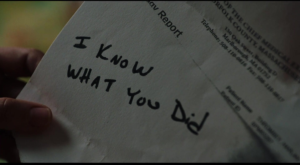 So the stress is on the danger to Marta, mounting higher and higher. Marta’s choice is to obey the instructions. Protecting herself is what’s important now, to Marta and to the story.
So the stress is on the danger to Marta, mounting higher and higher. Marta’s choice is to obey the instructions. Protecting herself is what’s important now, to Marta and to the story.
So we see that what drives Act II is threats, danger, uncertain outcomes. Will Marta be caught? Will she be exposed? Will she be bullied or guilted out of Harlan’s inheritance?
It’s an act full of external threats to Marta, and all the tension is on how they’re going to be resolved. That pegs Act II’s driving force as being Event.
Most stories have multiple threads, of multiple MICE types””but usually, they’re intertwined, woven together. Knives Out does something different: it distinguishes between them, sometimes to startling extremes. One reason Knives Out makes a great case study is that it sets its Idea and Event threads cleanly side by side for comparison.
Act I was full of interrogations; questions being asked and answered. Act II introduces Ransom, in exactly the same situation. But this time, when the Lieutenant says, “We’d like to ask you a few questionsâ “””, Ransom blows right past him. Or, when Blanc thinks Greatnana has a piece of the puzzle, he doesn’t have any questions for her. He doesn’t know what to ask. He doesn’t have a line of inquiry. What a difference from Act I!
And you’ll find that threats, danger, uncertain outcomes””the bread and butter of an Event thread””are as absent from Act I as questions are absent from Act II. None of the tension is the “success or failure” variety; there is no moment of “I hope this works.” Act I offers no stakes, no consequences to finding the murderer or letting him escape; nothing beyond the promise of a complex, satisfying puzzle.
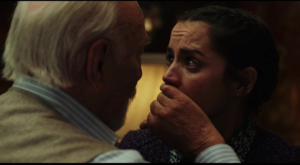 Even where you’d expect that a sense of danger would be absolutely necessary, it’s not there. Marta’s entire motive in following Harlan’s plan is the threat to her mother, yet she’s not the one who realizes it, who feels threatened. It’s Harlan who puts that together, while Marta gapes at him. That, right there, is the difference between “Marta’s mother could be deported” serving the story as an imminent threat, vs. as the answer to a question.
Even where you’d expect that a sense of danger would be absolutely necessary, it’s not there. Marta’s entire motive in following Harlan’s plan is the threat to her mother, yet she’s not the one who realizes it, who feels threatened. It’s Harlan who puts that together, while Marta gapes at him. That, right there, is the difference between “Marta’s mother could be deported” serving the story as an imminent threat, vs. as the answer to a question.
Once you have a sense of your various MICE threads, you can use them to understand your own story better. Here are some questions MICE can help you ask and answer:
What’s my beginning? What’s my end? Each MICE type makes a different kind of promise to the reader. A thread begins when a promise is made, and ends when it’s paid off.
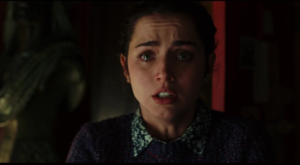 For an Idea story, the promise is a question; the payoff is its answer. Sure enough, Knives Out opens on a dead body, and ends with the culprit revealed. Even Act I, though, feels complete: it, too, ends with an answer, and a very definitive one. When Marta sees Harlan slitting his own throat, that’s the moment where the question has been firmly and completely answered””at least in Marta’s own mind.
For an Idea story, the promise is a question; the payoff is its answer. Sure enough, Knives Out opens on a dead body, and ends with the culprit revealed. Even Act I, though, feels complete: it, too, ends with an answer, and a very definitive one. When Marta sees Harlan slitting his own throat, that’s the moment where the question has been firmly and completely answered””at least in Marta’s own mind.
 For an Event story, the promise is a situation of crisis; the payoff is how that crisis is resolved. Act II’s crisis is “Will Marta manage to avoid detection,” and that thread’s start is Marta trying, really really hard, to destroy the evidence without being caught. Where does it end? When we resolve the tension: when Marta stops trying; when she accepts defeat. When she decides to dial 911 rather than let Fran die, that’s Marta hitting her limit. Discovering that limit is the conclusion of this story thread.
For an Event story, the promise is a situation of crisis; the payoff is how that crisis is resolved. Act II’s crisis is “Will Marta manage to avoid detection,” and that thread’s start is Marta trying, really really hard, to destroy the evidence without being caught. Where does it end? When we resolve the tension: when Marta stops trying; when she accepts defeat. When she decides to dial 911 rather than let Fran die, that’s Marta hitting her limit. Discovering that limit is the conclusion of this story thread.
How do I increase tension? Each kind of tension needs to be handled, and heightened, in its own particular way.
An Idea thread’s focus is a fascinating puzzle. So, increase tension by demonstrating how interesting, complex, and rewarding the puzzle is. Knives Out plays up complexity by introducing a family full of lies and intrigue; and shows it Does Puzzles Good by asking, and then solving, some small ones along the way.
In an Event thread, the focus is external conflict. So here, demonstrate how dangerous and overwhelming the threat is, and tease any potential reward. Act II keeps showing us new ways that Marta’s in great danger, but also her realization that she might become safer than ever before.
How do I introduce something important? If you want readers to care about something new, it’s easiest to connect it to something they already care about.
In an Idea thread, that means being relevant to the driving question. The family members are interesting because they’re suspects. Some of Marta’s earliest introduction is as a living investigation aid; someone who knows all the secrets and can’t lie.
In an Event thread, anything that can make the conflict go better or worse is automatically interesting. Consider Ransom, who fans the flames of the family infighting, and then swoops in to save Marta from an immediate threat. We’re interested in him not for answers, but for how he affects Marta’s situation; as a mover and shaker in the Event thread.
We’ve seen the clearest structural threads in Knives Out. (If you’re curious for the rest, the film has Milieu and Character threads as well. Identifying those is an excellent exercise”¦)
Hopefully, I’ve demonstrated how to use MICE to find those threads, and gain insight into them.
Don’t think of MICE like a Sorting Hat, squeezing any story into four arbitrary boxes. Remember the goal we’ve seen here: understanding what makes your particular story tick; how your story pulls readers forward, and how it pays off its promises. MICE gives you a stepping-stone to those big questions””an easy question first, to get you in the right ballpark.
Usually, you can take it from there.
All screencaptures by KissThemGoodbye.Net.
[1] MICE is detailed in Card’s writing books, How To Write Science Fiction & Fantasy and Characters and Viewpoint.
Here is a good summary, hosted by The Gunn Center for the Study of Science Fiction.
[2] For reference, the full script, via Deadline.
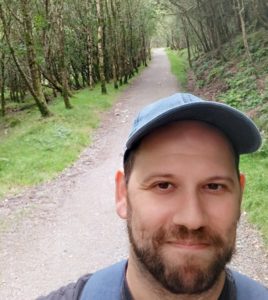 BIO: Ziv Wities is a short-fiction evangelist, a devoted beta-reader, and an Assistant Editor at Diabolical Plots. If you enjoyed this piece, Ziv’s website collects a selection of writing Q&A and his expert overanalyses of Too Like The Lightning and Star Trek: Discovery. He tweets, vaguely, as @QuiteVague.
BIO: Ziv Wities is a short-fiction evangelist, a devoted beta-reader, and an Assistant Editor at Diabolical Plots. If you enjoyed this piece, Ziv’s website collects a selection of writing Q&A and his expert overanalyses of Too Like The Lightning and Star Trek: Discovery. He tweets, vaguely, as @QuiteVague.
If you’re an author or other fantasy and science fiction creative, and want to do a guest blog post, please check out the guest blog post guidelines. Or if you’re looking for community from other F&SF writers, sign up for the Rambo Academy for Wayward Writers Critclub!
...
“But ser,” broke in one of the deckpaws. “The greatest jewel in the world is said to be guarded by the fearsome kraken, as tall as the queen’s castle with tentacles longer than ten vessels nose to tail!”
“Which is why, m’dear, we not be partakin’ of the flesh of the inkton,” Cinrak explained. “Kraken’s cousins have proven intelligent and good friends of Rodentkind. Friends not be eatin’ friends. The mer archives tell us, yes, once beasts of Kraken’s size did exist. It be not our place to tempt The Depth’s wrath.”
The entire crew undulated two digits in a v shape of warding.
– “Search for the Heart of the Ocean”
In Thor: Ragnarok, a motley collection of hunters challenges a confused Thor with, “Are you friend, or are you food?” It’s a play on the hail “friend or foe,” building a dangerous world reveling in its violence and cannibalism in one swift sentence.
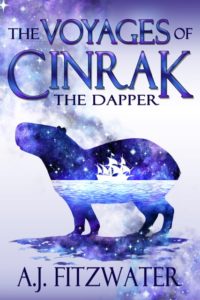 Cinrak’s rodent pirate world is one of fun, love, silliness, and respect. I wanted to create a through line about balance in community, nature, body, and spirit. What if pirates oversaw the equal distribution of resources? What if trans people had easy and equitable access to the health care they deserve? What if the monarchy answered to the people? What would keeping balance in the oceans look like?
Cinrak’s rodent pirate world is one of fun, love, silliness, and respect. I wanted to create a through line about balance in community, nature, body, and spirit. What if pirates oversaw the equal distribution of resources? What if trans people had easy and equitable access to the health care they deserve? What if the monarchy answered to the people? What would keeping balance in the oceans look like?
As the quote above suggests, respect for the sapience of ocean creatures is baked (see: puns most definitely intended in this book) into the myths, legends, and superstitions of Rodentdom. The great kraken, the protector of sea creatures, has not been seen for hundreds of years. Rather than take this as carte blanche to chow down on the crumbed calamari with chili sauce, the rodents ask what so upset the balance of life that an entire species would suddenly disappear.
In early drafts, I made strong points about climate change and over-fishing disturbing not just the way of life, but magic. This too upset balance; the sweetness and respect for letting the world building bleed in from the edges and the unspoken had been compromised. Opting for a softer approach, I let the silent Agnes””the enormous kraken of myth””speak for herself. She forms a bond with one of Cinrak’s crew, shows them the wonders of the ocean, and becomes a mascot to the Impolite Fortune. Playful as a puppy, and knowing her worth, Agnes unapologetically takes up space. She just wants to hug… the whole ship.
Agnes becomes the herald in “The Hirsute Pursuit.” Her link to the ocean grapevine (seawood tangle?) allows her to be first with the news that a once in a generation harvest is ready. This story introduces another significant piece of Rodentdom’s ecosystem: a food source with properties that acts like hormone replacement for trans people. The only magic in this microcosm is how it has been guarded to ensure equal distribution of resources. Are the fairies rodent-flesh eaters? Their biology and behavior suggest something to that effect in their distant past. Or they could have found a solution to defending their land against colonial invasion. Either way, when left alone they understand and undertake balance, sharing their bounty with the rodents.
The Voyages of Cinrak the Dapper is full of women who enjoy their food. Not for the spectacle of observers, but for pleasure and the nourishment of their bodies. As a pirate captain, Cinrak understands keeping her crew full, fit, and happy is a tool for community bonding and efficient livelihood. The food is in the detail. No one goes without a good cup of tea, or breakfast.
Including Agnes. Who cronches that shark with relish (pun alert!). Because she knows who is friend and who is food.
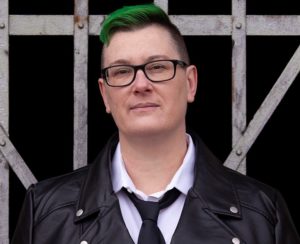 BIO: AJ Fitzwater lives between the cracks of Christchurch, New Zealand. Their work focuses on feminist and queer themes, and has appeared in venues of repute such as Clarkesworld, Beneath Ceaseless Skies, Shimmer, Giganotosaurus, GlitterShip, and in various anthologies. They are the author of rodent pirate escapades in The Voyages of Cinrak the Dapper and the WW2 land girls shapeshifter novella No Man’s Land. With a background in radio, AJ lends their voice to podcast narrations, including for the Escape Artists universe. They enjoy maintaining a collection of bow ties. A unicorn disguised in a snappy blazer, they tweet @AJFitzwater. Their website is pickledthink.blogspot.com.
BIO: AJ Fitzwater lives between the cracks of Christchurch, New Zealand. Their work focuses on feminist and queer themes, and has appeared in venues of repute such as Clarkesworld, Beneath Ceaseless Skies, Shimmer, Giganotosaurus, GlitterShip, and in various anthologies. They are the author of rodent pirate escapades in The Voyages of Cinrak the Dapper and the WW2 land girls shapeshifter novella No Man’s Land. With a background in radio, AJ lends their voice to podcast narrations, including for the Escape Artists universe. They enjoy maintaining a collection of bow ties. A unicorn disguised in a snappy blazer, they tweet @AJFitzwater. Their website is pickledthink.blogspot.com.
Purchase The Voyages of Cinrak the Dapper from your preferred retailer or directly from Queen of Swords Press.
If you’re an author or other fantasy and science fiction creative, and want to do a guest blog post or video interview, please check out the guest blog post guidelines. Or if you’re looking for community from other F&SF writers, sign up for the Rambo Academy for Wayward Writers Critclub!
...
So, love’s great, right? All types. It’s a fascinating quirk of brain chemistry that leaves us caring about each other so much we’ll sacrifice resources and fight against oppression for someone else’s wellbeing. Spending time with people you love is, to my mind, what life is all about. I just want to preface this with that little disclaimer, so nobody feels like I’m attacking love or romance.
Let’s talk about how we often centralize romance in fiction, how friendships get short shrift, and how the romance that we get is usually pretty one dimensional. First, let me own a bias. I’m asexual and aromantic. If you’re not familiar, that means I don’t experience sexual or romantic attraction. Platonic love is my everything. So, romance and sex don’t usually top the list of priorities for me in any storytelling context. That said, from a distance, I’m all for it. Unfortunately, fiction has gotten into some bad habits when it comes to dealing with friendships and romantic relationships.
Friendships are rarely given the focus they deserve. They are one of the most common types of relationships people have in their lives, and yet rarely do they get any nuance. In most fiction, friends are just there. They’re taken for granted. A friend is a person you talk to about your dating angst. It’s not uncommon in a lot of fiction for the entirety of two people’s platonic relationship to consist of them talking about their paramours. I’m not saying friends don’t do that with each other, but is that everything you do with your friends? In reality, friendships have just as much drama and excitement as romantic relationships. There is a moment when two people become friends, and it’s an exciting and fraught moment filled with insecurity, hope, and intrigue. There are events that cause those relationships to deepen, and tragically sometimes friendships end, and those endings can be heartbreaking.
Meanwhile the general lack of focus on platonic connection undercuts romantic relationships. Healthy romantic relationships have a platonic component. The old cliché is two people don’t get along, but it secretly means they like each other. In every longstanding romantic relationship I’ve ever encountered, the people involved liked one another. They had common interests. Two people have to be something when they’re not in the throes of sexual ecstasy or performing grand romantic gestures. Most of us are going to spend the lion’s share of our time together in sweatpants farting into the couch cushions, a set of circumstances that is far from the pinnacle of grand romance.
Sometime when you’re reading a romance novel, a story with romantic subplot, or watching a movie or television show that falls into the trope “two good looking people alone in a room: they’ve got to get together,” ask yourself, “Do these two actually have anything in common?” To be clear, I’m not saying everything in common. Great friendships are often defined by the differences between people, but amidst the differences there have to be points of commonality.
 So, why does this happen? The honest answer: it’s easy tension. Two good looking people, they don’t get along, but they’re so good looking. How could they not be interested in each other? It’s plausible they would date, then their totally incompatible personalities give writers a deep well of conflict and drama to draw from. And frankly, that’s okay. Who among us hasn’t leaned into a trope or two? Let those who have no ink on their fingers throw the first pen. However, it does become a problem when it’s done so ubiquitously that it starts to influence people’s conception of real-world relationships.
So, why does this happen? The honest answer: it’s easy tension. Two good looking people, they don’t get along, but they’re so good looking. How could they not be interested in each other? It’s plausible they would date, then their totally incompatible personalities give writers a deep well of conflict and drama to draw from. And frankly, that’s okay. Who among us hasn’t leaned into a trope or two? Let those who have no ink on their fingers throw the first pen. However, it does become a problem when it’s done so ubiquitously that it starts to influence people’s conception of real-world relationships.
Here’s the thing: fiction matters. It has real-world implications. Fiction without diversity normalizes a segregated world. Fiction with diversity challenges the status quo. Fiction rife with fundamentally incompatible romantic relationships makes fraught, tense, and incompatible romantic relationships seem normal. Meanwhile, when we treat friendships like they’re set dressing, we end up with a society where nobody puts the time and effort into maintaining friendships that they deserve.
So, what’s to be done? Well, next time you’re writing a romantic relationship, ask yourself, “What do these two do when they’re just hanging out?” In the space between grand romantic gestures and passionate lovemaking, who are they to each other? Do they like the same movies? Maybe they both like to cook. Maybe they’re big board game nerds. That doesn’t mean you can’t have the grand romantic gestures and the passionate lovemaking; just add the platonic love as well.
Next time you’re writing a friendship, ask yourself, “What holds these two together as friends?” There must have been moments in the past when they could have drifted apart. Why didn’t they? What do they see in each other that the myriad other people they’ve met in their lives didn’t quite appreciate? Who is this friend to your protagonist besides a useful literary device to move the plot along or an excuse to explicitly state some romantic subtext?
I’m not trying to lay all the problems of the world at fiction’s feet. There are a lot of forces in our society that diminish the significance of friendship and promote the idea that every problem in life can be solved by getting a date. But all too often, fiction isn’t helping. It’s not that hard to add that extra bit of nuance to relationships. There are good stories to be told that center friendships, even if they include romance. Superficial romantic relationships, with drama built on cheap interpersonal tension, are lazy. Spend a few moments thinking about your best friend. Think about how they make you feel. I’ll bet it’s a love story for the ages.
 BIO: Vincent Scott is a comedy science fiction writer and green tea… well, addict is a strong word, let’s say enthusiast. His new novel The Hereafter Bytes is being launched via Kickstarter to raise funds for a full release later in 2020. The campaign runs from March 11th to April 1st, 2020 and can be found here.
BIO: Vincent Scott is a comedy science fiction writer and green tea… well, addict is a strong word, let’s say enthusiast. His new novel The Hereafter Bytes is being launched via Kickstarter to raise funds for a full release later in 2020. The campaign runs from March 11th to April 1st, 2020 and can be found here.
You can connect with Vincent at twitter.com/writeitowldown.
If you’re an author or other fantasy and science fiction creative, and want to do a guest blog post, please check out the guest blog post guidelines. Or if you’re looking for community from other F&SF writers, sign up for the Rambo Academy for Wayward Writers Critclub!
...
I do my writing in between the cracks of a fulltime job, four dogs, two horses, and the renovation of our house, in which a lot of the work is done by my husband and myself. So yes, my writing time is precious. Very much so. However, most evenings, at least one hour of my time, and sometimes more, is not spent drafting, revising, or editing. Not exclusively. That time is spent in an online writing community, where I am one of the founding members.
For some people who, like me, live in a part of the world where English is not a prevalent language, where cons are few and far between and writing groups even more of an oddity, these online groups are pretty much the only opportunity we have to interact with other writers on a regular basis.
...
I joked recently that it seems like every story has to end with some gigantic battle. That’s how we know it’s the end, right?
Think about it. Which of the world’s great legends tell us that our problems should be addressed through something OTHER than violence?
Hercules, Beowulf and Gilgamesh all killed monsters. King Arthur’s knights in shining armor maintained the peace by fighting monsters. If no monster was about, they would fight each other to catch a lady’s eye. Lord of the Rings featured massive battles for the fate of the world. Military SF, of course, features more technologically advanced weaponry in exotic settings, but the role of the warriors remains the same. It seems the only way to “save” anything is through battle.
Then you get to other forms, like comic books. Superheroes level cities to bring in the bad guys. For this, we admire them. In gaming, the only way to get XP and level up is by killing things. Very few games award XP for clever solutions that avoid combat. Then there are movies, where we may move from combat to combat without time to think. The more explosions, the better!
It’s true that the world can be violent. Depicting violence in stories could be seen as mere honesty. Although, it’s hard to believe that most of us experience that much violence personally, in our daily lives. Not in proportion to the amount of violence we consume as entertainment.
Or perhaps the violence in storytelling is a form of wish fulfilment. As a teacher, I’m well aware of how much time we spend teaching kids NOT to solve their problems with their fists. Watching an animated fight could be viewed as a safe release for dark impulses.
Nevertheless, I was startled to realize how often I, myself, built in a gigantic battle to settle things at the ends of my stories. It wasn’t something I had really thought about. In the accepted frameworks, that’s the way it’s supposed to be done.
Still, it became my personal challenge to write stories where characters solve their problems in some other way than through battle.
For the past two years, I’ve been working on a novella series, Minstrels of Skaythe, where the protagonists try to live peacefully in a dark and dangerous world. In Skaythe, the evil mage Dar-Gothul is an absolute ruler who has twisted the world in his image. Mages are the ruling class, whose magical power gives them the right to do whatever they wish. Selfishness and betrayal are “good.” Showing concern for others is “bad.” My good mages quietly move through the land, disguised as minstrels. They share moments of peace and harmony through their arts. For this, they are branded as renegades.
In the first novella, The Tower in the Mist, one of the minstrels is arrested for the crime of singing a love song. Keilos doesn’t fight back, but instead reacts with basic courtesy. The hunter-guards, led by Sergeant Zathi, are genuinely freaked out by his strange behavior. Captors and captive have adventures that require them to work together, but not all of the hunter-guards can let go of their assumptions about what’s “good” and “bad.”
In the second novella, Dancer in the Grove of Ghosts, Tisha is a gifted healer. She’s decided to undo a curse cast by Dar-Gothull himself. On the way there, she encounters a gravely wounded guardsman. Common sense would say Cylass is her enemy. It’s sheer folly to help him, but Tisha follows her own moral code. Devoted to peace, she tries to show Cylass a different path “” and risks betrayal by the one she saved.
While writing it, I played with the idea that comrades on a quest always have a strong bond of friendship and are working for a common goal. Setting them so much at odds brought a deeper tension to the tale.
Currently I’m in revisions of a third novella, The Ice Witch of Fang Marsh. Here I directly countered the idea that the tale has to end in a gigantic battle. I built the story toward that typical climax, but then the two antagonists talked, instead.
I have to say, the ending as written feels… weird. Like the conflict isn’t really over. My beta readers both said the same. Not that the ending was bad, or felt forced, just that they hadn’t seen that approach before.
Unsettled as it is, this outcome is what’s true to the characters. They had a previous relationship that allowed them to talk things out. Or maybe it’s that they were two women, with an instinct toward collaboration rather than combat.
Will this ending satisfy anyone besides me? Good question! I’m having a great time with Minstrels of Skaythe, exploring alternatives to the nagging prevalence of violence in storytelling. If you’re up for the challenge of a slightly strange outcome, I hope you’ll check out my novellas, The Tower in the Mist and Dancer in the Grove of Ghosts.
 BIO: Deby Fredericks has been a writer all her life, but thought of it as just a fun hobby until the late 1990s. She made her first sale, a children’s poem, in 2000.
BIO: Deby Fredericks has been a writer all her life, but thought of it as just a fun hobby until the late 1990s. She made her first sale, a children’s poem, in 2000.
Fredericks has six fantasy novels out through two small presses. More recently, she self-publishes her fantasy novellas and novelettes, bringing her to 13 books in all. Her latest is The Tower in the Mist. Her short work has been published in Andromeda Spaceways and selected anthologies.
In addition, she writes for children as Lucy D. Ford. Her children’s stories and poems have appeared in magazines such as Boys’ Life, Babybug, Ladybug, and a few anthologies. In the past, she served as Regional Advisor for the Inland Northwest Region of the Society of Children’s Book Writers and Illustrators, International (SCBWI).
You can find out more on her website or follow her on Twitter. Here’s a teaser for her novella Dancer in the Grove of Ghosts, available at Amazon and other retailers:
“He’s dead. He just doesn’t know it yet.”
Mortally wounded, Cylass is abandoned on the battlefield by comrades who would just as soon have him out of the way. But as he waits for death, a strange savior appears. The dancer, Tisha, heals him with her forbidden magic, but also draws the wrath of his cruel former lord.
Soon guardsman and renegade mage are on the run. Will Cylass help Tisha, as she helped him? Or will he do the smart thing, and turn her over to the vicious Count Ar-Dayne?
If you’re an author or other fantasy and science fiction creative, and want to do a guest blog post, please check out the guest blog post guidelines. Or if you’re looking for community from other F&SF writers, sign up for the Rambo Academy for Wayward Writers Critclub!
...
 Treading the waters of diversity is tricky because we never want to disrespect the struggles that women, people of color, the LGBTQ community, or others have had to endure. As writers, we often want to include people like this in our stories because their stories are powerful and can make a difference. This sometimes manifests itself as ‘the gay friend’ or ‘the black friend’ or if you’re really batting for a home run ‘the gay black friend’. This character is great for diversity. He shows that those people exist and that we shouldn’t be afraid of them. But over time, if we see the gay black friend over and over it creates a subliminal message that all gay black men behave a certain way, and that can damage the community. I think we should allow those characters to break the mold and keep it to themselves.
Treading the waters of diversity is tricky because we never want to disrespect the struggles that women, people of color, the LGBTQ community, or others have had to endure. As writers, we often want to include people like this in our stories because their stories are powerful and can make a difference. This sometimes manifests itself as ‘the gay friend’ or ‘the black friend’ or if you’re really batting for a home run ‘the gay black friend’. This character is great for diversity. He shows that those people exist and that we shouldn’t be afraid of them. But over time, if we see the gay black friend over and over it creates a subliminal message that all gay black men behave a certain way, and that can damage the community. I think we should allow those characters to break the mold and keep it to themselves.
Gender identity, skin color, and sexual orientation don’t affect your ability to do things. Period. There’s no reason a gay man can’t be a hardened combat veteran and there’s no reason a straight man can’t enjoy ballet. The fact that we use these stereotypes reflects our perceptions of society. It acts as a shorthand for the reader / viewer to go “Oh, he’s the gay guy, I get it!” and we can immediately paint a picture of who that person is without digging any deeper. While it’s great to include someone like this in your story, you may actually do more harm than good by treating them this way. Why? Because you’re adding to society’s confirmation bias. If every time someone sees a gay man on TV or reads about them in a book and they behave like a giddy teenage girl, then we will continue to think that’s how all gay men behave. Not that there’s anything wrong with a flamboyant personality, but it can be an oversimplification of the gay community.
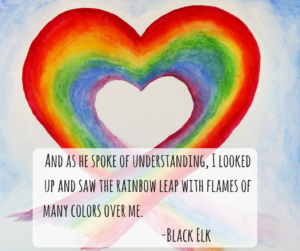
What if, instead, we put a gay man in a position of power? The NBC show Brooklyn 99 does this with the character Captain Raymond Holt. He’s a stoic, calculating man that comes off cold but everyone loves him anyway. Just because he lacks flamboyance doesn’t make him any less gay. He still has a pride flag on his desk and there are many episodes with his husband, but he’s not treated any different because of his sexual preference. Yes, there are some episodes about his struggles as a gay black man in the NYPD because that is a story worth telling, but his skin color and sexual orientation never interfere with his ability to perform his duties. That’s because they literally have no bearing on his performance, and his entire team treats him the same as they treat everyone else. Imagine the impact that has for people who have never met a gay man like him. For some people, it never occurs to them a gay man could behave that way. For some people, that character is eye-opening and possibly life-changing.
Wizards of the Coast, a gaming company that owns Dungeons & Dragons and Magic: The Gathering (among others), often portrays people of color as their flagship heroes. They even have several prominent non-binary characters, which they’ve supported despite friction from some members of the community. Imagine the impact when someone who’s never played one of these games, in an industry that has traditionally been dominated by white dudes, thumbs through one of the rule books and sees a heroic character that looks like them. The imagination stirs as we consider the possibilities of being that character. It makes us feel like we could be part of that adventuring group, part of the epic story that will be written as a legend in years to come. All because of some simple artwork!

Placing these characters front and center, without necessarily making their differences the focus of the narrative, can have a profound effect on society. By having these characters represented in our stories we are saying, “This is how life is, these people exist and they don’t need to be treated any different than you or I.” This silent diversity becomes powerful representation for these communities. It reinforces the idea that we are all equal. If a child sees a hero that looks like them on the cover of a book, or on a movie poster, it tells them they could be that hero. It tells them there are other people with their unique traits in the world and that those people can accomplish great things. It tells them they aren’t alone.
You know what’ll never get old? Seeing representation in games. I used to be one of those people that said it didn’t matter but every time I see someone that looks like me on screen its a feeling like no other. pic.twitter.com/FwdP5rukHE
“” ThatBronzeGirl (@ThatBronzeGirl) November 20, 2019
Does this mean you can’t tell a story about a person of color’s struggles? Of course not. Am I suggesting that a woman’s climb to the top of her field isn’t worth hearing about? No. I’m saying that if we fast-forward through the struggles these people face every day and portray them as successful heroes then maybe society will treat them like heroes. In the end, we all want equality. We want a world where our gender identity, skin color, sexual preference or any other part of our being is accepted without a second thought.
Why not nudge society in that direction by telling stories where that is already true?
BIO: Kyle Winter is an author who is terrible at writing about himself, especially in the third person. He considers himself a genre-fluid author, dabbling in science-fiction, fantasy, pulp and others. He is an avid gamer, whether it be video games, tabletop RPGs, miniatures, board games or card games nothing is safe. For the past nine years he has routinely gotten beat up at his Brazilian jiu-jitsu classes and enjoys every second. You can visit his website www.TheKyleWinter.com or connect with him on Twitter @TheKyleWinter.
If you’re an author or other fantasy and science fiction creative, and want to do a guest blog post, please check out the guest blog post guidelines. Or if you’re looking for community from other F&SF writers, sign up for the Rambo Academy for Wayward Writers Critclub!
...
 As a writer, it’s normal to want to share stories about the diverse and interesting world around you. That can be difficult if you have to write a character with a completely different background and life experience than you. The important thing is to stay away from writing a stereotype or a character that’s unbelievable. To help you, this article will share five helpful suggestions to create excellent and multi-layered LGBT characters.
As a writer, it’s normal to want to share stories about the diverse and interesting world around you. That can be difficult if you have to write a character with a completely different background and life experience than you. The important thing is to stay away from writing a stereotype or a character that’s unbelievable. To help you, this article will share five helpful suggestions to create excellent and multi-layered LGBT characters.
1. Don’t be stereotypical
In today’s world, producers and audiences alike want to see diversity in books, movies, and TV shows. But creating a stereotypical LGBT character just to fit the demand isn’t good enough. Instead, create a multi-dimensional person with a storyline… and they happen to be gay as well.
According to a writer at Academized and State of Writing, Jamie Lyndham, “a good suggestion is when you’re creating a character, ask yourself if and why they need to be heterosexual or cisgender (identifying with their birth-assigned gender). Think about if you could enhance your story by changing their gender identity or sexuality.”
...
Want access to a lively community of writers and readers, free writing classes, co-working sessions, special speakers, weekly writing games, random pictures and MORE for as little as $2? Check out Cat’s Patreon campaign.

"(On the writing F&SF workshop) Wanted to crow and say thanks: the first story I wrote after taking your class was my very first sale. Coincidence? nah….thanks so much."